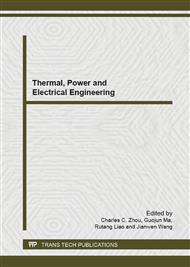[1]
Alexander, K. V., Giddens E. P., Fuller A. M., 2008, Optimum penstocks for low head microhydro schemes, J. of Renewable Energy, Vol. 33, pp.1379-1391.
DOI: 10.1016/j.renene.2007.01.009
Google Scholar
[2]
Alexander, K.V. Giddens, E. P., Fuller, A.M., 2009, Axial-flow turbines for low head micro hydro systems. J. of Renewable Energy, Vol. 34, pp.35-47
DOI: 10.1016/j.renene.2008.03.017
Google Scholar
[3]
Singh, P. and Nestmann, F., 2011, Experimental investigation of the influence of blade height and blade number on the performance of low head axial flow turbines, J. of Renewable Energy, Vol. 36, pp.272-281.
DOI: 10.1016/j.renene.2010.06.033
Google Scholar
[4]
Singh, P. and Nestmann, F., 2010, Exit blade geometry and part-load performance of small axial flow propeller turbine: An experimental investigation, J. of Renewable Energy, Vol. 34, pp.798-811.
DOI: 10.1016/j.expthermflusci.2010.01.009
Google Scholar
[5]
Singh, P. and Nestmann, F., 2009, Experimental optimization of a free vortex propeller runner for micro hydro application, J. of Renewable Energy, Vol. 33, pp.991-1002.
DOI: 10.1016/j.expthermflusci.2009.04.007
Google Scholar
[6]
Ferro, L. M. C., Gato, L. M. C., and Falcao, A. F. O., 2011, Design of the rotor blades of a mini hydraulic bulb-turbine, Renewable Energy, Vol. 36, pp.2395-2403.
DOI: 10.1016/j.renene.2011.01.037
Google Scholar
[7]
Ramos, H. M., Simăo M., and Kenov, K. N., 2011, Low-head energy conversion: A conceptual design and laboratory investigation of a microtubular hydro propeller, International Scholarly Research Network ISRN Mechanical Engineering, ID: 846206.
DOI: 10.5402/2012/846206
Google Scholar
[8]
Dixon, S. L., 2005, Fluid Mechanics, Thermodynamics of Turbomachinery, Elsevier, Oxford, UK, Chapters 2, 6 and 9.
Google Scholar
[9]
Gorla, R. S. R. and Khan, A. A., 2003, Turbomachinery Design and Theory, Marcel Dekker, New York, Chapters 1 and 3.
Google Scholar
[10]
Wilcox, D. C., 1986, Multiscale model for turbulent flows, AIAA 24th Aerospace Sciences Meeting, American Institute of Aeronautics and Astronautics, pp.1598-1605.
DOI: 10.2514/6.1986-29
Google Scholar
[11]
Menter, F. R., 1994, Two-equation eddy-viscosity turbulence models for engineering applications, AIAA J., Vol. 32(8), pp.1598-1605.
DOI: 10.2514/3.12149
Google Scholar
[12]
ANSYS CFX ver.13 User's Guide, 2011, ANSYS Inc.
Google Scholar


